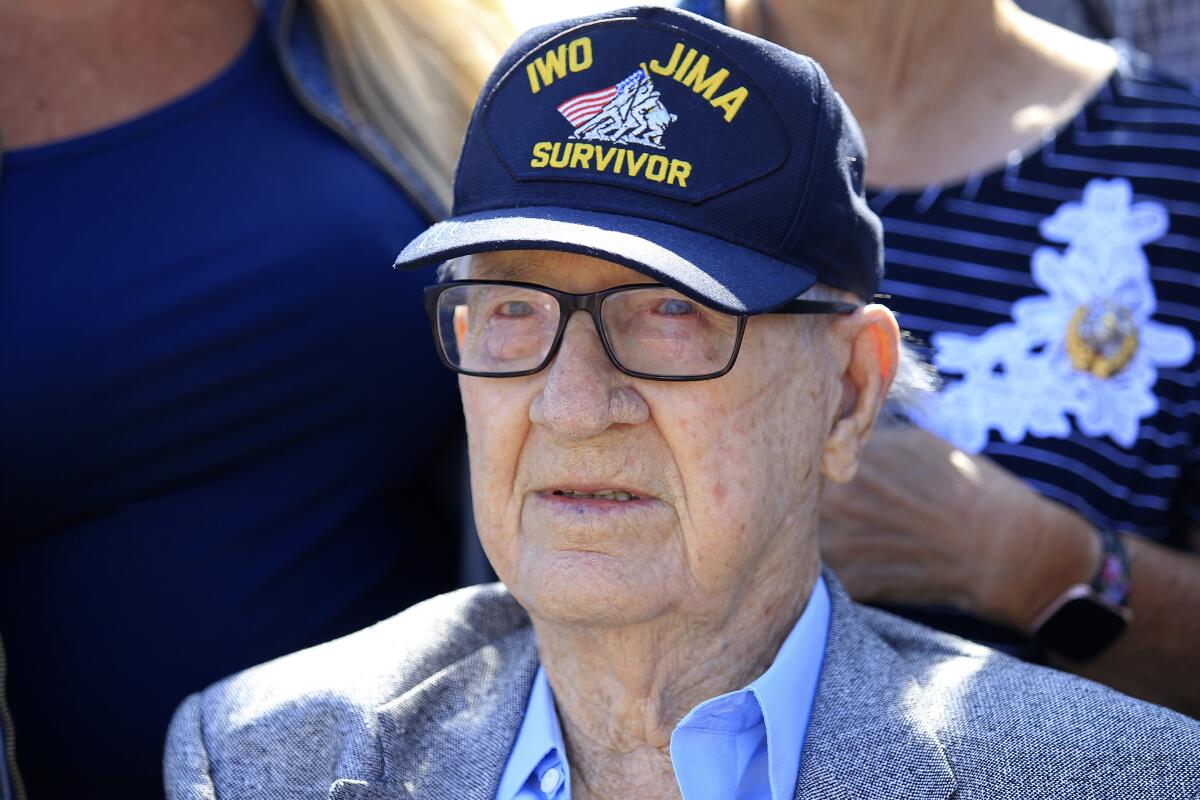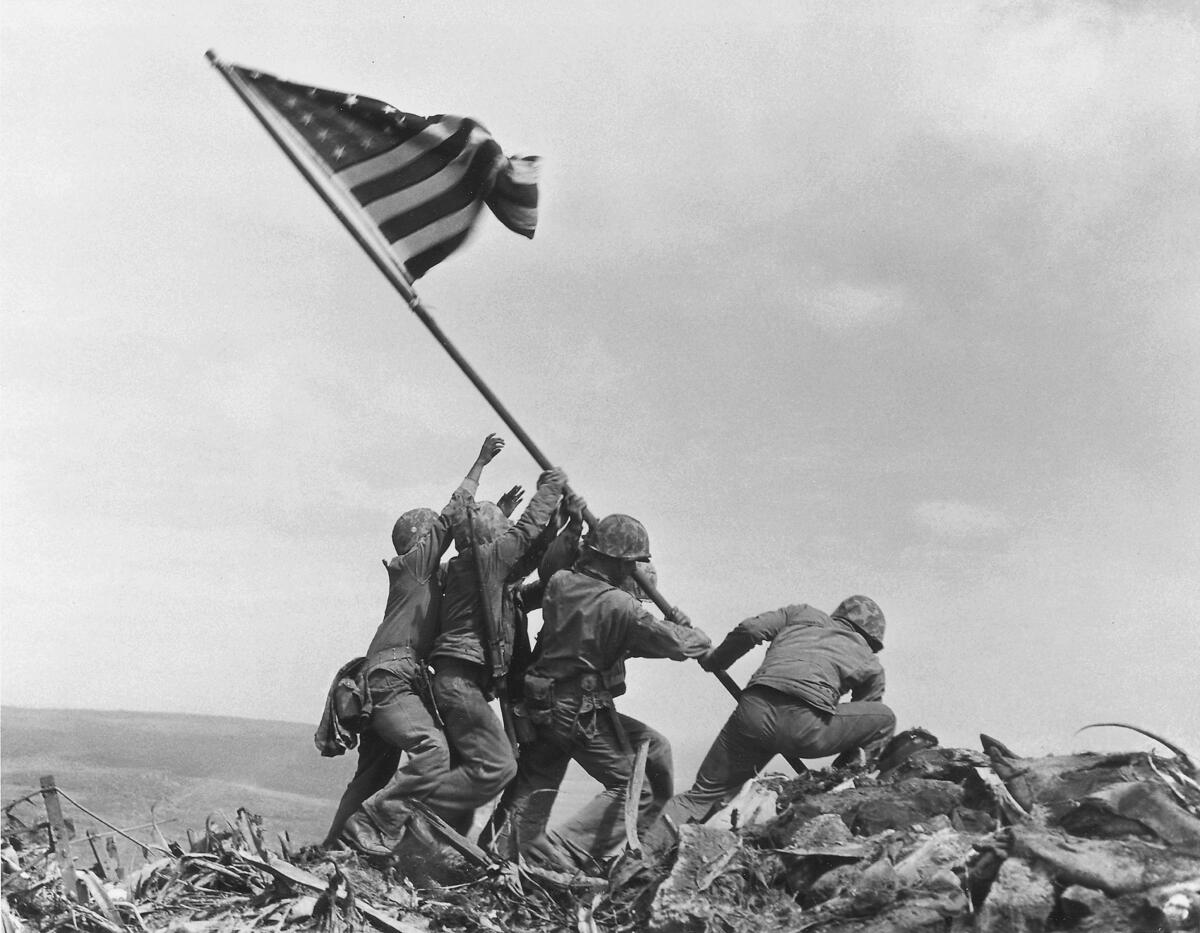Dave Severance, Marine leader whose troops planted flag on Iwo Jima, dies at 102

- Share via
SAN DIEGO — Dave Severance, a retired U.S. Marine colonel whose troops famously planted a U.S. flag on Iwo Jima during World War II, died Monday at his home in La Jolla. He was 102.
There were actually two flag-raisings that February morning in 1945, the second of which was captured in one of warfare’s most iconic photographs. Severance spent years quietly trying to set the record straight about who did what back then, and why.
He cared about the flag story, he told the San Diego Union-Tribune in a 2012 interview, because it spoke to the courage and sacrifice he witnessed every day for more than a month during the battle, one of the bloodiest of the war.
His company came ashore in the 10th wave of what eventually would be about 70,000 Marines invading the island, a strategic slab of dormant volcano about 660 miles south of Tokyo. They were met by some 20,000 Japanese entrenched in fortified caves and tunnels and determined to die rather than surrender.
Severance’s 240-man, six-officer unit out of Camp Pendleton (Company E, 2nd Battalion, 28th Regiment, 5th Division) spent 33 of the battle’s 36 days on the front lines. About 75% of the company was killed or wounded.
He earned a Silver Star — “I tell people it’s for surviving,” he would later joke — and had several close calls, including a bullet that went between his legs and struck a lieutenant standing behind him.
Born Feb. 4, 1919, in Milwaukee, Severance grew up in Colorado and joined the Marines in 1938, hoping to become a pilot. He came to San Diego for boot camp and wound up in the ground forces.
Severance first saw combat in December 1943, on Bougainville, where his patrol unit turned aside a Japanese ambush. Sent back to San Diego and then Hawaii for additional training, he was promoted to captain and dispatched to Iwo Jima.
On Feb. 23, 1945, the fifth day of fighting, about 40 members of Severance’s company were sent up Mt. Suribachi, the highest point on the island, with orders to plant the flag. When it was raised, Americans on the island cheered. Ships offshore blew horns and sirens.
“The event,” Severance recalled, “gave a real boost to the morale of the troops in the midst of a grim battle.” He and others thought the fighting would soon be over. They were wrong.
A short time later, another group was sent up with a second flag to replace the first. Associated Press photographer Joe Rosenthal followed and took the picture that would become famous and win a Pulitzer Prize: six men heaving the pole into position, the Stars and Stripes snapping in the wind.

The photo ran in newspapers across the country, an image so powerful it stirred the spirits (and war-bond-buying wallets) of Americans. Later, it became the model for the Marine Corps War Memorial in Arlington, Va.
It’s also been a source of controversy, with various people coming forward over the years to claim they had a role in raising the flag. Rosenthal, who died in 2006, was dogged the rest of his life by rumors that he had staged the photo.
For many years, the official Marine version had it that the first flag was replaced because the battalion commander, Lt. Col. Chandler Johnson, wanted a larger one that more troops could see. That’s not what Severance remembered.
When the first flag was raised, he said, Secretary of the Navy James Forrestal, who had just arrived on the island, asked to have it as a souvenir. “Hell, no,” Johnson said, according to Severance. “We put it up there, and we are going to keep it.”
A second group of Severance’s Marines was sent up with orders to replace the flag. The Marines would keep the first one, and the Navy secretary would get the replacement, which flew over Mt. Suribachi for the rest of the battle. Both flags are now in the National Museum of the Marine Corps near Quantico, Va.
After years of writing letters about the flag-raising, Severance got a note in 2014 that the Marines would include an addendum in their records, acknowledging that there’s more to the story.
He became a pilot after World War II and flew combat missions during the Korean War, earning a Distinguished Flying Cross. He was promoted to colonel in 1962 and retired six years later.
In his home in La Jolla, Severance had a copy of the Rosenthal picture, signed by the photographer. He also had a poster for the 2006 movie “Flags of Our Fathers,” about the Iwo Jima battle, signed by director Clint Eastwood. Severance, portrayed in the film by Neal McDonough, was a consultant on the movie.
His death was first reported Wednesday by the New York Times, which attributed the information about his passing to his family.
Survivors include two daughters, Nina Cohen and Lynn Severance; two sons, Dave Jr. and Mike Severance; and several grandchildren and great-grandchildren. He was predeceased by his second wife, Barbara, who died in 2017. His first marriage, to Margaret, ended in divorce.
The New York Times contributed to this report.
More to Read
Sign up for Essential California
The most important California stories and recommendations in your inbox every morning.
You may occasionally receive promotional content from the Los Angeles Times.











